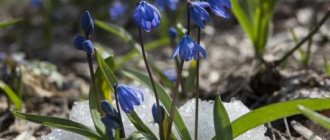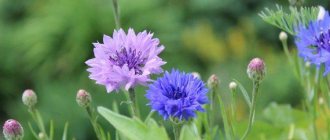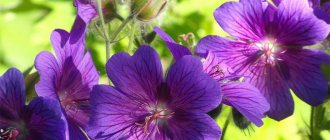An incredibly attractive plant is coleus. Planting and care in open ground, as well as cultivation, are the subject of our conversation. After all, the beauty of its foliage is not inferior to the buds and inflorescences of bright garden flowers and is sure to be the focus of attention and attracts glances. If you find a competent approach to coleus and provide it with everything you need, it will become a magnificent decoration for your site!
Coleus and verbena, photo
Coleus flowers for landscape design
Thanks to selection, decorative crop species have been developed that are characterized by increased resistance to adverse weather conditions. This made it possible to use coleus in landscape design as an annual plant with annual planting.
The plant can be dominant in a flower bed or serve as a background for other crops.
Coleus looks great in mixed plantings, when using varieties with different shades of leaves. It can also be combined with other garden crops.
The beauty of the plant is especially evident when planted together:
- in mixborders;
- in the flower beds;
- curbs;
- discounts;
- single- and multi-level compositions.
In landscape design, coleus is used:
- for decorating the root zone of trees;
- when creating floral topiary sculptures;
- hanging types of crops in hanging flowerpots are used for landscaping gazebos;
- As a container culture, outdoor coleus planted in flowerpots serves as decoration for recreation areas.
Usage
In its homeland, the plant is used not only as a decorative garden decoration, but also grown for food. Some varieties of coleus have edible roots.
For example, on the island of Java, a variety of Blume with black tubers is grown, which are used for food. In Sudan, the Nigro variety is grown, which has dark, huge tubers. In Madagascar, a variety with small gray or yellowish-pink nodules is grown as a food product, and in Africa, coleus tubers reaching 20 cm in diameter are used as food.
Growing conditions
Coleus prefers sunny open places, slightly shaded at midday and protected from cold gusts of wind. The optimal temperature for the plant is +15-25 degrees.
Coleus is undemanding to soil composition. The main thing is that it is loose, nutritious and with a neutral level of acidity. For active growth of coleus, air humidity is required in the range of 65-70%. Therefore, during dry periods, the plant must not only be watered regularly, but also sprayed. When growing coleus in pots, it is necessary to especially carefully control the soil moisture, preventing the roots from drying out.
Planting and caring for coleus in open ground
It is recommended to plant coleus in a flower garden in the spring, when the soil has warmed up well to a depth of 15 cm and the threat of return frosts has passed. To do this, you need to make holes 10 cm deep at a distance of 25 cm. There is no need to deepen the plants when planting. At the end of the procedure, water the coleus and cover it with agrofibre for quick adaptation for several days.
Watering and fertilizing
Caring for coleus outdoors involves regular watering throughout the growing season. Moistening can be carried out using a hose using the sprinkling method as the top layer of soil dries out in the evening. With a lack of moisture, the leaves and shoots of the plant droop. It should be taken into account that the crop does not tolerate stagnant moisture in the soil.
Coleus is characterized by an accelerated rate of bush development, which requires adequate nutrition.
The plant needs to be fed every 7-10 days throughout the season. To do this, you can use mineral complex fertilizers for decorative deciduous plants with a minimum nitrogen content.
Pruning and shaping a coleus bush
To maintain the high decorative value of coleus in the garden, it is necessary to properly form the bushes. It is recommended to pinch the top of young seedlings by 1-2 cm. This will increase their branching. If necessary, the procedure can be repeated several times during the season.
Systematic removal of flowers
The flowering of coleus is not particularly decorative. It only slows down the development of the plant and weakens it. When flower stalks appear, it is better to remove them in a timely manner.
Autumn care, transplanting into pots and autumn pruning
Coleus is a heat-loving crop. it will not survive the winter in open ground. To preserve the plant until the next season, it is necessary to transplant it into a pot when the temperature drops in the fall to +12 degrees. You cannot delay the procedure, as with further cold weather the coleus will die. After transplanting, the shoots of the plant need to be shortened by half.
Coleus care in winter
For successful wintering, shoots need a bright room with a temperature of +12-15 degrees. During this period, it is necessary to water the plant moderately, only as the top layer of soil dries 1-1.5 cm.
Bloom
How does coleus bloom? Why are flower stalks removed? The flowers of the plant are inconspicuous, purple or bluish, blooming on the tops of long shoots. They are collected in false whorls, which form a spike-shaped inflorescence.
Flowering lasts from June to September. After this, nut-shaped fruits with small seeds are formed. Under natural conditions, coleus blooms throughout the year. Some varieties do not set seeds.
Coleus propagation
Coleus propagates easily. You can use cuttings and seeds to obtain new seedlings. Each method has certain features that you need to pay attention to.
Cuttings
This propagation method is used by flower growers for vegetative varieties of coleus, which do not retain their species properties when sowing seeds, for example: Margosha, Snow Carousel.
Coleus can be taken from cuttings at any time of the year.
To do this, it is necessary to cut off healthy apical shoots from the center of the bush, 10 cm long. Each cutting should have 2-3 pairs of leaves. Before planting in a damp substrate, it is necessary to remove the lower plates and powder the tip of the shoot with any root former. After this, plant the cuttings in the substrate, deepening them down to a couple of leaves, and compact the soil at their base.
The cuttings should be kept on a bright windowsill at a temperature of +22-24 degrees. For better rooting, they must be covered with transparent caps. If all conditions are met, roots will form within 2 weeks.
Seeds
To plant coleus seeds, you need to prepare wide containers, 10 cm high. They need to be filled with nutritious substrate and moistened. Place the seeds on top at a distance of 1-1.5 cm, sprinkle with a 0.3 cm layer of soil, and then moisten with a spray bottle. After planting, the containers should be covered with film and moved to a dark place with a temperature of +22-24 degrees.
After germination, which occurs after 10-14 days, the containers should be moved to a bright windowsill and the maintenance regime should be lowered for a week to +19-20 degrees. When the seedlings become stronger, they need to be adapted to external conditions, and then the film is removed. At the stage of 2-3 true leaves, it is recommended to pick young plants into separate containers.
Description of the plant
Coleus belong to the Lamiaceae family, genus Coleus (lat. Coleus). Changes have been made in the modern classification and only 2 species remain in the genus Coleus - Coleus decumbens and Forskola. Most of the remaining species are transferred to the genus Spurflower.
In nature they grow up to 3 m in height, but when grown in pots they do not exceed 80-100 cm. Their growth can be limited by planting in relatively small pots or pruning.
In our gardens we usually grow the perennial Coleus Blume (Blume), which is also called Plectranthus scutellarioides, synonym Coleus blumei. The plant is also called plectranthus, spur flower, nettle or colored nettle, due to its leaf similar to nettle. The plant comes from tropical areas of Asia, Australia and the Pacific Islands.
The name Coleus Bloom perpetuates the memory of the Dutch botanist Carl Ludwig Bloom (1796-1862), who conducted research in Indonesia, where coleus grows in natural areas.
The coleus plant, with its vibrant tropical flowers, will inject energy into any garden and add original, exotic beauty. The leaf shape is heart-shaped or oval, reminiscent of nettles.
The most famous and expensive coleus in the world is depicted in the painting Coleus in a Pot from 1886. It was painted by Vincent Van Gogh (1853-1890).
Coleus bloome is a perennial grown as an annual or potted plant in heated rooms in winter.
Characteristics of the type:
- Plant height : 30-50 cm, rarely reaching 1-1.5 meters.
- The stem is square in cross section. In older plants it is hollow and becomes woody, but retains its characteristic shape.
- The flowers are inconspicuous, collected in whorl inflorescences, blue, lilac or violet.
- The leaves are very decorative, usually variegated, in shades of burgundy, purple, orange, pink, green, yellow. Single-color varieties are rare. The length of the leaf blade varies from 5 to 15 cm. The shape of the leaf is from oval to deltoid, the tip is pointed, the edges are serrated, the surface is pleasantly velvety to the touch. Like the rest of the plant, the leaves emit a bitter aroma when crushed.
- Application : for flower beds, borders, planting in containers, boxes, pots on balconies, terraces.
- Frost resistance : none. Coleus die at temperatures below 8 degrees Celsius.
Possible problems, diseases and pests of coleus
If the rules of planting and care are followed, the coleus flower looks healthy, as in the photo, and does not cause any special problems for the gardener. If appropriate growing conditions are violated, the plant loses its decorative effect and looks dejected.
Possible difficulties:
- Rotting of the stem at the base. This sign indicates stagnation of moisture in the soil. In this case, first the leaves lose turgor, and then the coleus dies
- Pale color of the plates. This problem occurs when the bushes are insufficiently illuminated. To correct the situation, the plant needs to be replanted.
- Premature leaf fall. Coleus does not respond well to drafts. Therefore, when this sign appears, the plant must be moved to a secluded place in the garden. Pests can also cause damage to coleus bushes, namely aphids, spider mites, whiteflies, and scale insects. If signs of damage appear, it is necessary to spray the plant with Actellik, Fitoverm or Inta-vir.
Peculiarities
Coleus has been one of the favorite plants of landscape designers and gardeners for many years. This extremely colorful crop does not require painstaking care and decorates flower beds and paths from late spring to September or October.
In combination with other garden plants, Coleus has become a classic garden decor. Thus, burgundy and purple varieties perfectly set off silvery cineraria and alyssiums or yellow marigolds.
Harmonious combinations are obtained when creating compositions from Coleus, lilies, sage, gypsophila, and salvia. In monoplantings, plants of the same variety of contrasting colors are usually chosen. Using Coleuses of the same height but different colors, designers create entire “Persian carpets” with intricate patterns.
Coleus is an indispensable participant in the landscaping of large parks, private plots, dachas and even city apartments. The photos show that the abundance of varieties allows you to choose the right flower for any interior.
An additional advantage of the culture, flower growers call its versatility. Coleus can be grown at home, then in a flower bed, and then returned to the room as a whole bush or cutting.











